Beulah is a village in Breconshire which lies astride the main A483 road, about eight miles south-west of Builth Wells. The village Church, Eglwys Oen Duw (Lamb of God), was built in 1867, and is situated a mile north-west of the village. Also within the village lies Beulah Congregational Chapel. The Chapel contains a war memorial to the 64 men of the district who served during the Great War and to the eight men who fell.
The Great War, 1914-1918
David Davies, Private, 33332, Welsh Regiment. David was the son of William Davies and Elizabeth Davies (nee Griffiths), of Gwynnebyrhaul, Beulah. He enlisted at Cardiff into the Welsh Regiment and was posted to Rhyl to join the 14th (Swansea) Battalion, Welsh Regiment, which was attached to 129 Brigade, 43rd (Welsh) Division. On 29 April 1915 the formation became renumbered to 114 Brigade, 38th (Welsh) Division and in August 1915 moved to Winchester to complete its training. David did not embark for France with the 14th Welsh on 2 December 1915 but joined the battalion in the Spring of 1916. The Division then held a sector of the line near Cuinchy before marching south to the Somme sector in June 1916 to take part in the assault on Mametz Wood. The first attack on the wood was launched on a two-battalion front on 7 July, but failed, and the Divisional Commander, Sir Ivor Philipps, was replaced before the Division attacked again on a two Brigade front on 10 July 1916. DSavid was killed in action during the terrible fighting in the wood that day, 10 July 1916. The 32-year-old has no known grave and is commemorated on the Thiepval Memorial, France.
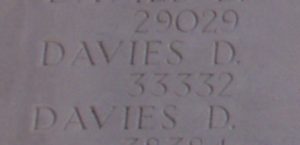
Frangcon Davies, Private, 41975, Welsh Regiment. Frangcon was the son of William Davies and Elizabeth Davies (nee Griffiths), of Gwynnebyrhaul, Beulah. He had resided at 1, Blaen y Morfa, New Dock, Llanelli prior to the war, and enlisted there into the army. Frangcon was posted to the 23rd Battalion, Welsh Regiment, which was the Pioneer Battalion to the 28th Division. The Division moved to France during January 1915, and saw its first major action during the Second Battle of Ypres. It then fought at Loos in September that year, before entraining for Marseilles, where it sailed for Salonika in October 1915. The Salonika front had opened due to the invasion of Serbia by a combined Bulgarian and Austrian force, so the British and French despatched several divisions to guard the border of Greece, where the Serbian army had been forced to withdraw. Frangcon was wounded at Salonika and died on 5 October 1916. He was 20 years old, and is buried in Lahana Military Cemetery, Greece.
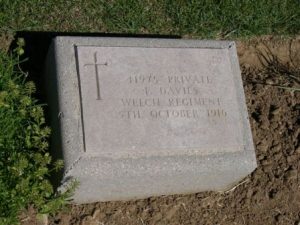
Idris Powell Davies, Second Lieutenant, Cheshire Regiment. Idris was born on 24 June 1896, the son of David Davies and Mary Davies, of Garth Mill Farm, Garth. He worked with his brother at Davies and Vick grocers, The Circle, Tredegar prior to enlisting in the summer of 1916 as a Private into the Welsh Field Ambulance, which was attached to the 68th (2nd Welsh) Division. He spent much of his time at war on home service but was commissioned as Second Lieutenant into the Cheshire Regiment on 26 February 1918. Idris was then drafted to France on 17 June 1918 and was posted to the 7th Battalion, King’s Shropshire Light Infantry, which was attached to 8 Brigade, 3rd Division. Idris joined the battalion in reserve at Gosnay, then on 4 July the 7th KSLI moved into the front line at Locon to begin a short spell in the trenches. The 3rd Division was then relieved by the 19th (Western) Division and moved by bus to Dieval where intensive training was carried out. The 7th KSLI moved to Saulty on 13 August and to Monchy three days later, taking up assembly positions at Adinfer Wood. Here the battalion received orders to carry out an attack on the line of the Arras to Bapaume railway, between a level crossing and a sunken road. The attack was launched at 04.45 on 21 August 1918, as part of an overall advance by the British on the Somme front. By 07.30 the battalion had captured all its objectives. Idris was struck in the head by a machine-gun bullet during the attack that day and died soon afterwards. The body of the 22-year-old was carried back behind the lines and he was buried in Bienvillers Military Cemetery, France.
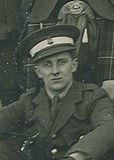
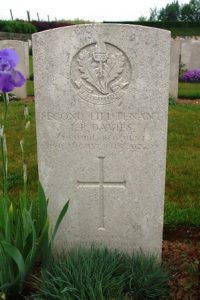
David Jones, Private, 3671, Welsh Guards. David was the son of Edward and Jane Jones, of Cefngardis, Beulah. He worked as a gardener in Caerphilly prior to the war and lived with his wife, Elizabeth Annie Jones, at 89, Oxford Street, Nantgarw. David enlisted into the Welsh Guards at Caerphilly and after completing his training was drafted to France in the autumn of 1917, joining the 1st Battalion, Welsh Guards, which was attached to the 3rd Guards Brigade, Guards Division. The Guards Division saw heavy fighting at Ypres, during the opening assault on the Pilckem Ridge and during the later stages of the offensive, before being moved south, to take part in the Battle of Cambrai. By the end of November, the Guards Division was in the thick of the action fighting a valiant defensive action near Bourlon Wood following the launching of the German counter-attack. The Guards then held the line at Gouzeaucourt before being relieved and moved to billets in Arras by 11 December 1917, to rest and rebuild. On 1 January 1918 the Welsh Guards left Arras to move back into the front line near Gavrelle and over the coming weeks rotated between duty in the front line, in reserve and then in billets at Arras. On 10 March 1918 the Welsh Guards had moved back into the line, near Fampoux and launched a raid against the Germans facing them. David was killed in action during the raid that day. The 30-year-old is buried in Level Crossing Cemetery, Fampoux, France.
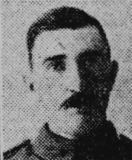
Milwyn Jones, Lance Corporal, 54041, Welsh Regiment. Milwyn was born on 19 February 1895, the son of John Josiah Jones and Mary Jones (nee Davies), of Preswylfa, Beulah. He was educated at Llwyn Madoc School, Beulah before finding work at the Levers Oil Mills. Milwyn enlisted into the 4th Battalion, Welsh Regiment in August 1914. The battalion was the Carmarthenshire Territorial unit and mobilised for war at Carmarthen in August 1914, as part of South Wales Brigade, Welsh Division and moved to Tunbridge Wells until the end of the month, before moving to Scotland to man the Forth and Tay Defences. On 17 April 1915 the battalion moved to Bedford, joining 158 Brigade, 53rd (Welsh) Division. On 19 July 1915 the entire Division sailed from Devonport for Imbros and on 9 August 1915 landed at Suvla Bay. The infantry moved off the beaches across the Salt Lake, under shellfire, into the scrub covered Chocolate Hill, but due to a lack of maps and no knowledge of the terrain, many of the units became disorientated, and the situation became chaotic. Milwyn was wounded in the foot during the landings and was forced to have a toe amputated. He was hospitalised at Lemnos where he contracted dysentery and was evacuated back home. He re-joined the 4th (Reserve) Battalion at Haverfordwest in January 1916 and was drafted to France in September, joining the 15th (Carmarthenshire) Battalion, Welsh Regiment, which was attached to 114 Brigade, 38th (Welsh) Division. The Division had suffered terrible casualties in Mametz Wood in July that year, then took over a section of the front at Hébuterne before moving to the Ypres Salient, taking over the Canal Bank sector at Boesinghe. The infantry battalions of the Division then began carrying out the normal pattern of rotation in the trenches, four days in the front, four in support and four in reserve, whilst also working on trench improvement, digging new trenches, and also carrying out regular patrols and trench raids whilst it prepared for the forthcoming opening of the Passchendaele offensive. On 28 July 1917 the 15th Welsh were in the Canal Bank line when it came under fire from low flying German aeroplanes. Milwyn was killed by a shell whilst attempting to rescue a wounded man that day. The 22-year-old is buried in Bard Cottage Cemetery, Belgium.
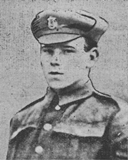
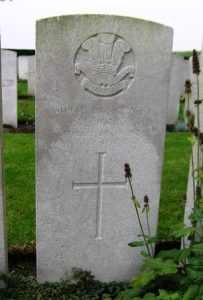
Evan William Price, Private, 267516, Monmouthshire Regiment. Evan was the son of William and Charlotte Price, of Pencoylan, Beulah. He enlisted into the 2/1st Brecknockshire Battalion, South Wales Borderers at Brecon on 19 October 1914. In April 1915 the battalion moved to Dale, as part of the Milford Haven defences and at the end of 1915 moved to Bedford to join the 68th (2nd Welsh) Division. Evan then transferred to the Monmouthshire Regiment and was drafted to France on 30 July 1916, joining the 1/2nd Battalion, Monmouthshire Regiment, which was by then the Pioneer Battalion to the 29th Division. The Division had suffered heavy losses during the opening day of the Somme offensive, during its assault on Y-Ravine, and was then pulled out of the line to rest and rebuild before moving back into the line and taking part in the latter stages of the Somme offensive. Evan took ill during his first winter in France and was evacuated home after contracting enteric fever. He was sent to the 2nd Western General Hospital at Manchester where he was also found to be suffering from pthisis and on 10 April 1917 was discharged from the army as medically unfit. Evan returned home to Beulah, where he died of tuberculosis on 7 October 1917. The 19-year-old was buried in Eglwys Oen Duw Churchyard. Evan is not commemorated by the CWGC.
Edgar Williams, Private, 206741, Welsh Regiment. Edgar was the son of Evan and Mary Williams, of Glancammarch, Beulah. He was educated at Beulah and at Builth Wells County School before enlisting at Brecon into the 2/1st Brecknockshire Battalion, South Wales Borderers soon after the outbreak of war. In April 1915 the battalion moved to Dale, as part of the Milford Haven defences and at the end of 1915 moved to Bedford to join the 68th (2nd Welsh) Division. Edgar was drafted to France in 1916, joining the 1st Battalion, South Wales Borderers, which was attached to 3 Brigade, 1st Division. He probably joined the battalion on the Somme, following heavy fighting around Bazentin Wood, but shortly afterwards was wounded and evacuated home. Upon his recovery, Edgar returned home on leave in April 1918 before being drafted back out to France and joined the 1/6th Battalion, Welsh Regiment, which was the Pioneer Battalion to the 1st Division. The Division saw heavy fighting in Flanders in April following the launching of the German offensive on the Lys. By the beginning of May the fighting had slowed down, due to the Germans launching another offensive on the Aisne and the 6th Welsh settled down to improving the defences around Sailly Labourse, where it remained over the coming months. To the south, the Allies launched a great offensive on 21 August and began driving the Germans back towards the Hindenburg Line. The 1st Division joined the offensive a week later, moving to the Arras sector and attacking the Drocourt-Queant Switch Line. A week later the Division moved to the Villers-Bretonneux area and joined the great advance in this new sector. Every night as the Division advanced, the 6th Welsh went to work, erecting barbed wire defences in front of the newly captured positions, often under heavy fire. Edgar was killed during the early hours of 25 September 1918 when he was struck in the throat by a shell fragment. The 19-year-old is buried in Vermand Communal Cemetery, France. His brother, Ivor, died in 1922 of ill-health contracted during the war.
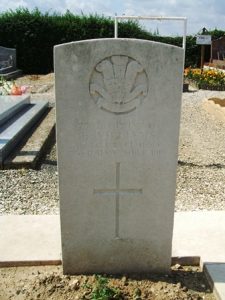
Ivor Williams, Private, 267549, Monmouthshire Regiment. Ivor was the son of Evan and Mary Williams, of Glancammarch, Beulah, Garth. He worked as a postman at Beulah prior to the war. Ivor enlisted into the Brecknockshire Battalion, South Wales Borderers at Llanwrtyd Wells on 26 February 1909 and over the coming years attended the annual TA summer camps at Porthcawl, Aberystwyth, Haverfordwest, Hereford and at Haverfordwest again. Despite his experience, upon being mobilised in August 1914, Ivor was almost immediately discharged from the battalion as medically unfit and returned home. Ivor then re-enlisted into the Monmouthshire Regiment on 28 October 1914. He was drafted to France in 1916, joining the 2nd Battalion, Monmouthshire Regiment. Ivor served with the battalion in France for the next 18 months before taking ill and was diagnosed as suffering from nephritis. He was discharged from the army on 13 April 1918 as medically unfit and returned home. Ivor eventually died of ill-health on 16 October 1922, aged 35. Nothing further is known of him as he is not commemorated by the CWGC. His brother, Edgar, had been killed in France in 1918.